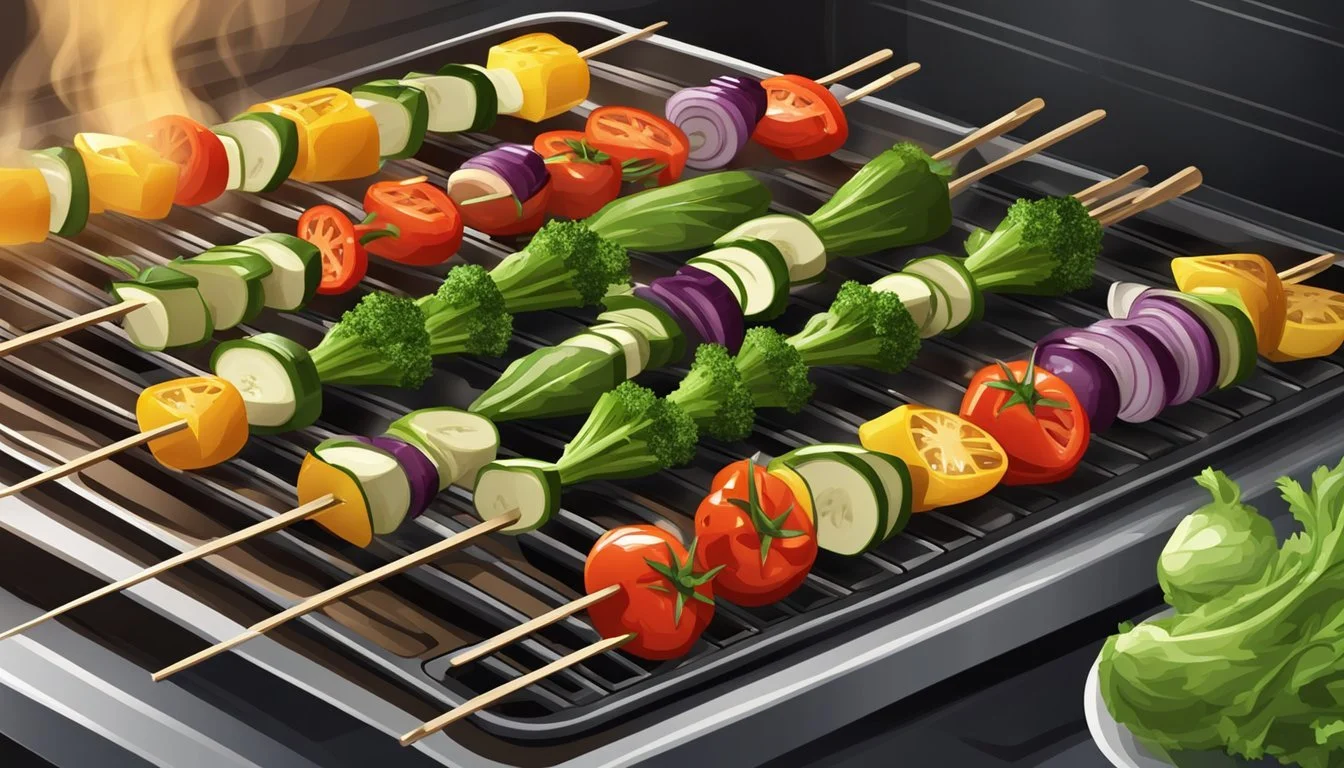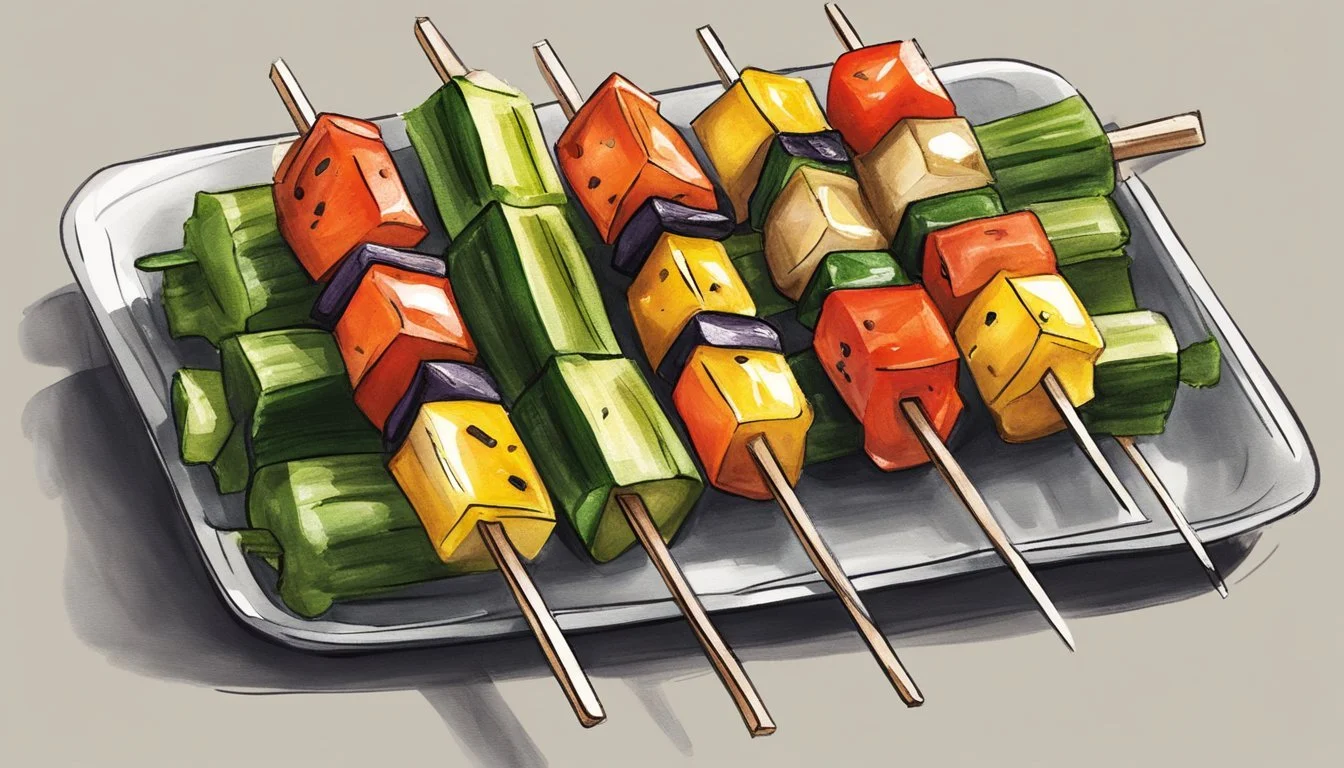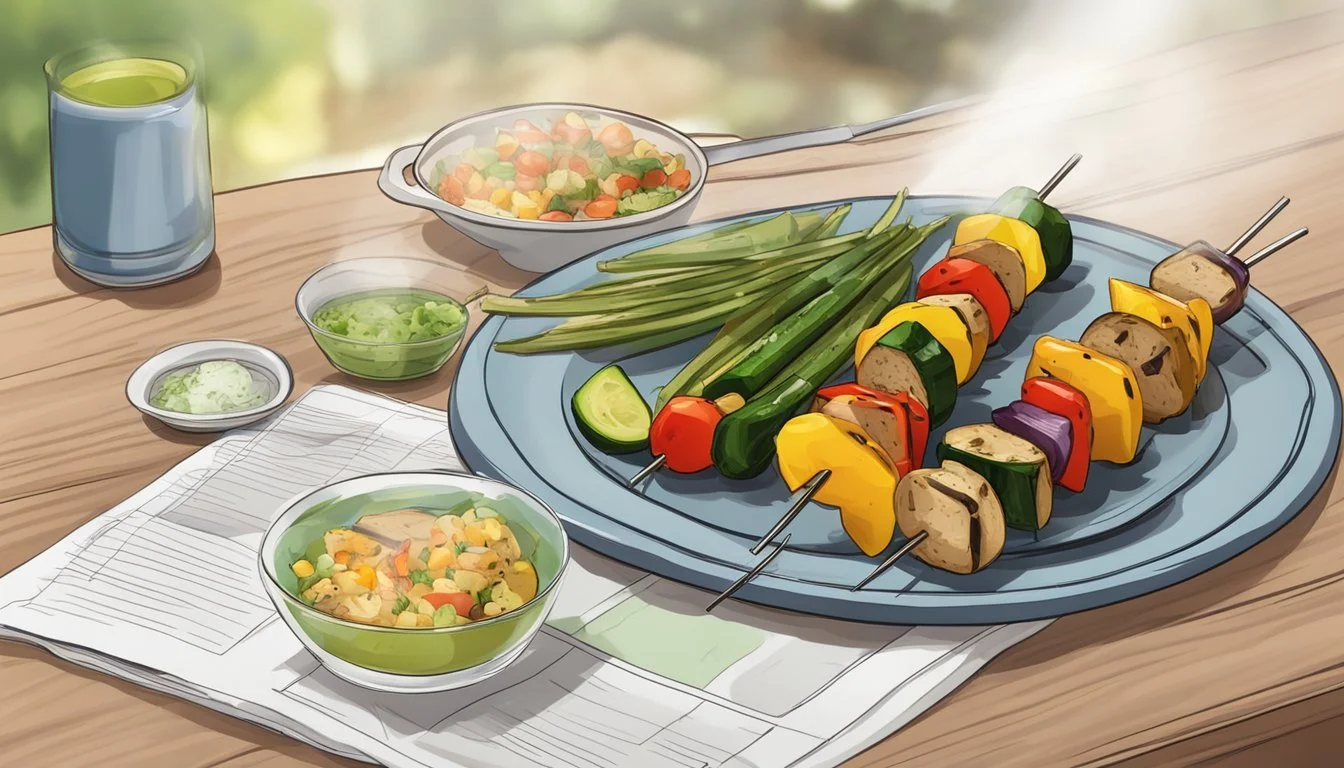How to Reheat Gluten-Free Grilled Vegetable Skewers
Best Methods for Perfect Results
Gluten-free grilled vegetable skewers are a delicious and healthy option for any meal, but what happens when you have leftovers? Reheating these savory skewers without losing their flavor and texture is essential. Whether you’re looking to enjoy them as a quick snack or incorporate them into another dish, you’ll find that reheating with the proper technique can make all the difference.
These skewers, packed with vibrant vegetables like zucchini, bell peppers, and mushrooms, can be easily prepared and stored. Brush them with a sauce or marinade before grilling to enhance their taste. When it's time to reheat, using methods like the stovetop, microwave, or air fryer will ensure you maintain their deliciousness without making them soggy or overcooked.
For those mindful of dietary needs, these gluten-free skewers retain their nutritional value and taste after reheating. Proper reheating methods will help preserve their crispness and flavor, making meal prep simple and offering versatility for various meals throughout the week.
Understanding Gluten-Free Grilling
Preparing gluten-free grilled vegetable skewers requires attention to ingredient selection and proper culinary techniques. Selecting vegetables and skewers carefully ensures a delicious and safe meal.
What is Gluten-Free Cooking
Gluten-free cooking eliminates foods containing wheat, barley, rye, and oats. It is essential for those with celiac disease or gluten sensitivity. To prevent cross-contamination, use clean tools and prep spaces.
Dedicated utensils and grills simplify gluten-free preparation. Mark specific areas as "gluten-free only" to maintain separation.
Choosing the Right Vegetables for Grilling
Select vegetables that grill well, such as bell peppers, zucchini, mushrooms, and cherry tomatoes. Wash and cut them evenly for consistent cooking.
Marinate the vegetables with gluten-free seasonings and marinate for better flavor. Store them in an airtight container if marinating in advance.
Types of Skewers: Wooden vs Metal
Wooden skewers:
Soak in water for at least 30 minutes before use to prevent burning.
Disposable, which simplifies cleanup.
Risk of splinters if not handled properly.
Metal skewers:
Reusable and more environmentally friendly.
Conduct heat, which can help with even cooking.
Need careful handling as they can get very hot.
Both types have their advantages; choose based on personal preference and convenience.
Preparation of Vegetables
Ensuring that vegetables are properly prepared can significantly enhance the flavor and texture of gluten-free grilled vegetable skewers. Key steps include washing and cutting the vegetables, marinating them for optimal flavor, and adhering to recommended prep and cook times.
Washing and Cutting Veggies
It's essential to thoroughly wash all vegetables to remove dirt and pesticides. Use cold water and gently scrub the surface of the vegetables.
Bell peppers, zucchini, yellow squash, and eggplant should be cut into uniform chunks to ensure even cooking. Red bell peppers and onions can be cut into large pieces, while cherry tomatoes can remain whole. Mushrooms should be cleaned with a damp cloth and sliced if large. Consistent size and shape of the veggies will help achieve even grilling.
Marinating Vegetables for Flavor
A simple marinade can elevate the taste of the vegetables. Combine ingredients such as olive oil, lemon juice, minced garlic, parsley, and oregano. For a bit of heat, consider adding Aleppo pepper or red pepper flakes.
Place the vegetables in a large bowl, pour the marinade over them, and toss to coat evenly. Let the vegetables marinate for at least 30 minutes, but preferably up to 24 hours for a more intense flavor. Store marinated veggies in an airtight container in the refrigerator if prepping in advance.
Prep Time and Cook Time Guidelines
Prep time includes washing, cutting, and marinating, which takes about 30-45 minutes depending on the number of vegetables.
For optimal grilling, preheat the grill to medium-high heat (around 400°F to 425°F). Arrange the veggies on skewers, ensuring each skewer has a mix of different vegetables for balanced flavor in each bite.
Grill the skewers for approximately 8-10 minutes, turning halfway through to ensure even cooking and grill marks. Vegetables should be tender and slightly charred when done. This short cook time paired with the marinating ensures they remain juicy and flavorful.
Grilling Techniques
Achieving perfectly grilled gluten-free vegetable skewers requires specific techniques to ensure maximum flavor and the right texture. It's important to focus on preheating, oiling the grill, and understanding alternative methods for cooking.
Using the Grill for Perfect Veggies
Preheat the grill to medium-high heat, aiming for a temperature between 400°F and 425°F. This ensures a good sear on the vegetables. Lightly oil the grill grates to prevent sticking.
Arrange skewers on the grill, leaving space between each for even heat distribution. The recommended cook time is about 4 minutes per side, enough to achieve charred grill marks without overcooking.
Check the vegetables frequently to avoid burning, turning the skewers at least once during grilling. Use tongs to manage the skewers safely and efficiently.
Alternative Cooking Methods
If a grill is unavailable, a grill pan can be used. Preheat the grill pan on the stovetop to medium-high heat. Follow the same oiling and spacing guidelines as you would for an outdoor grill.
An air fryer offers another alternative. Preheat the air fryer to 400°F and arrange the skewers in a single layer. Cook for 8-10 minutes, turning halfway through.
An oven broiler also works well. Preheat the broiler and place skewers on a broiler pan. Broil for 4 minutes on each side, ensuring even charring.
Each method aims to achieve similar results in terms of flavor and texture, offering flexibility for different cooking environments.
Reheating Instructions
Properly reheating gluten-free grilled vegetable skewers preserves their texture and flavor. Here are different methods to achieve the best results.
Reheating in the Oven
To reheat gluten-free grilled vegetable skewers in the oven:
Preheat the oven to 350°F (175°C).
Arrange skewers on a baking sheet lined with aluminum foil or parchment paper.
Cover loosely with another piece of aluminum foil to prevent excessive drying while allowing heat circulation.
Bake for approximately 10-15 minutes or until the vegetables are warmed through. Be careful not to overheat, which can cause the vegetables to become too soft.
This method is ideal as it evenly warms the skewers without losing moisture.
Microwave Reheating Method
For a quick and convenient option, use the microwave:
Place skewers on a microwave-safe plate and cover with a microwave-safe lid or another plate to trap steam.
Add a tablespoon of water to the plate to help maintain moisture.
Heat on medium power for 1-2 minutes, checking halfway through. Rotate the skewers to ensure even heating.
Continue heating in 30-second increments until the skewers are warmed to your liking.
Avoid overheating to preserve the texture of the vegetables.
Reheating Options Without a Microwave or Oven
If an oven or microwave is unavailable, other methods can be used:
Stovetop Method: Heat a skillet over medium heat. Add a small amount of water or vegetable broth to create steam. Place the skewers in the skillet, cover with a lid, and heat for 3-5 minutes, turning occasionally.
Air Fryer Method: Preheat the air fryer to 350°F (175°C). Place skewers in the basket in a single layer. Heat for 5-7 minutes, shaking the basket halfway through.
These alternative methods ensure that the vegetable skewers retain their moisture and flavor without relying on traditional ovens or microwaves.
Optimal Serving and Storage
Properly serving and storing gluten-free grilled vegetable skewers ensures they retain their flavor and texture while minimizing waste.
Serving Suggestions
Serve gluten-free grilled vegetable skewers warm, ideally straight from the grill, for best texture and taste. Pair these skewers with a simple side dish such as quinoa or a mixed green salad.
Arranging the skewers on a large platter with a dipping sauce, like a garlic tahini or a balsamic glaze, enhances the dining experience. If serving at a gathering, keep them warm using a chafing dish.
Vegetable skewers also make an excellent addition to a Mediterranean-themed meal, alongside dishes like hummus, pita bread, and tzatziki. Ensure the accompaniments are also gluten-free to maintain dietary consistency for guests.
Storing Leftover Skewers
To store leftover skewers, first, let them cool to room temperature. Remove the vegetables from the skewers and place them in an airtight container. Label the container with the date for easy tracking.
Store leftovers in the refrigerator for up to 3-5 days. For reheating, consider using a stovetop skillet with a bit of water or broth to preserve moisture.
Alternatively, use an air fryer or microwave for convenience, but avoid overcooking. These methods ensure the reheated vegetables retain their flavor and don’t become overly soft. Proper storage and reheating keep the leftover skewers as delicious as when they were freshly grilled.
Nutritional Information
Gluten-free grilled vegetable skewers offer a nutritious option that is low in calories, rich in vitamins, and adaptable for various dietary needs. This section covers the caloric and macronutrient breakdown and how to adjust the recipe to suit specific dietary requirements.
Caloric and Macronutrient Breakdown
Vegetable skewers are inherently low in calories and high in nutrients. A typical serving size (approximately 2 skewers) contains:
Calories: 70-100
Protein: 2-3 grams
Fat: 4-6 grams (from olive oil/marinade)
Carbohydrates: 10-15 grams
Fiber: 3-4 grams
The exact values depend on the vegetables and marinade used. For instance, bell peppers are high in vitamin C, while zucchini and mushrooms add fiber and various B vitamins.
Adjusting the Recipe for Dietary Needs
For those following a vegan diet, ensure that the marinade is free from animal products like honey or dairy. Substitute with agave nectar or use a combination of olive oil and balsamic vinegar with herbs.
To reduce the fat content, minimize the amount of oil in the marinade. Alternatively, use a cooking spray instead. For a protein boost, consider adding tofu cubes marinated along with the vegetables. Adjust seasoning to personal taste preferences, which can help maintain the flavor while adhering to dietary restrictions.
Enhancing the Grilled Skewers Experience
To take your grilled vegetable skewers to the next level, consider experimenting with various seasonings and pairing them with complementary dishes for a more balanced meal.
Experimenting with Seasonings and Herbs
Enhancing flavor with seasonings and herbs transforms simple veggie skewers into a culinary delight. A mix of olive oil, salt, and pepper often serves as a base for many marinades. However, using a blend of smoked paprika, garlic powder, and cumin adds a smoky kick.
Fresh herbs like rosemary, thyme, or basil can elevate the taste of grilled vegetables. Marinate vegetables with a mix of lemon juice, oregano, and thyme to infuse a Mediterranean vibe. Alternatively, pairing with cilantro and lime brings a refreshing, tangy twist.
Pro Tip: Tossing in some sesame seeds or a dash of red chili flakes can add both texture and heat.
Pairing with Complementary Dishes
For a satisfying and balanced meal, pairing veggie skewers with complementary side dishes is key. Quinoa salads with fresh herbs and a light vinaigrette can balance the rich, smoky flavors of grilled vegetables. Couscous dishes with dried fruits and nuts provide both flavor and texture.
Grilled vegetable kabobs can also be paired with hummus or tatziki for a delightful dipping experience. For protein-rich sides, grilled chicken or tofu complement well without overshadowing the veggies.
Refreshing beverages like lemonade or iced tea can also enhance the overall dining experience by providing a counterbalance to the smoky notes of the grilled skewers.









